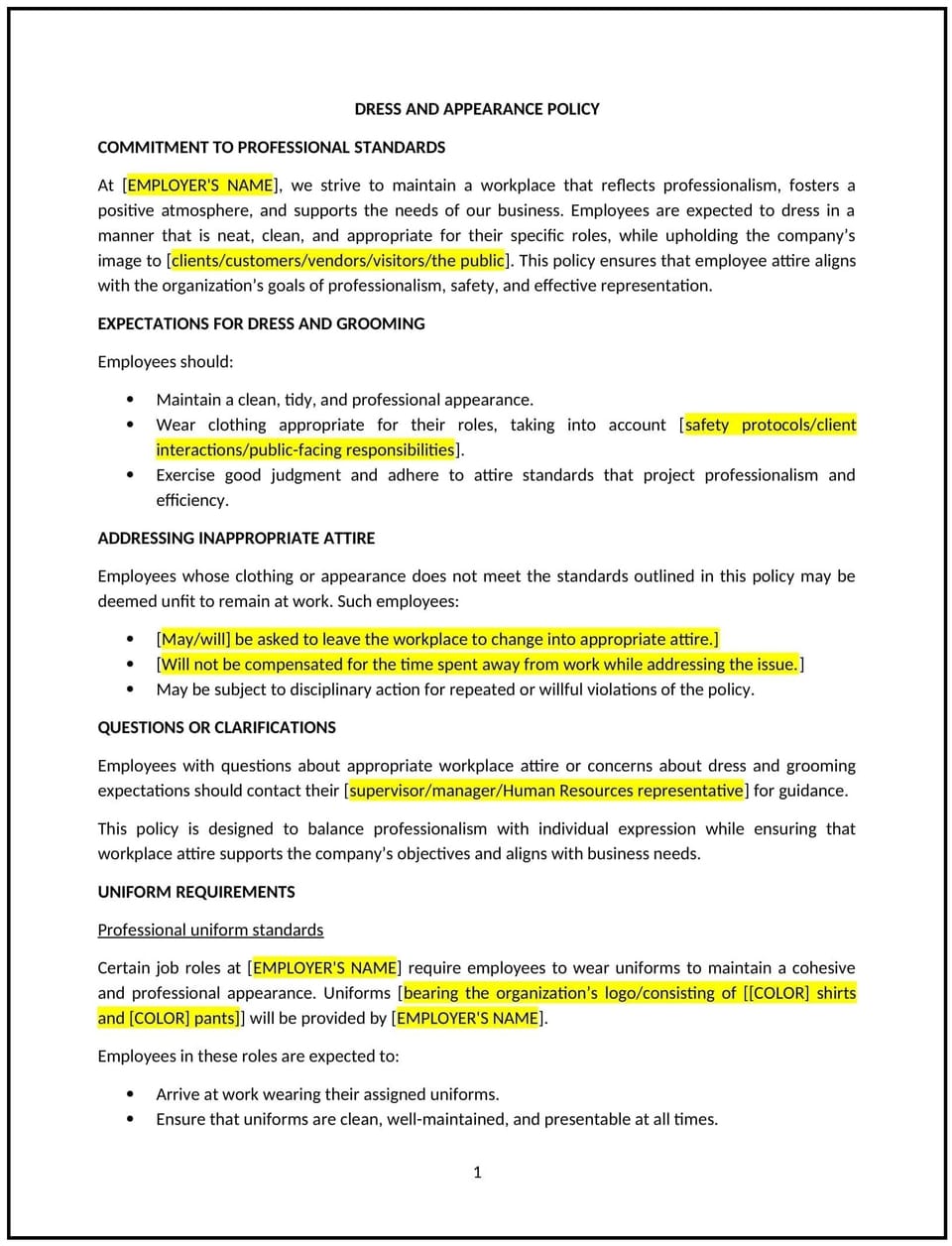Dress and appearance policy (California): Free template

Dress and appearance policy (California)
In California, a dress and appearance policy provides businesses with guidelines for employee attire and grooming standards in the workplace. This policy ensures that expectations for professional appearance are clear while supporting compliance with California laws, such as the Fair Employment and Housing Act (FEHA), which prohibits discrimination based on personal characteristics, including hairstyles or religious attire.
This policy outlines acceptable dress codes, accommodations for cultural or religious practices, and procedures for addressing non-compliance. By implementing this policy, California businesses can promote professionalism, inclusivity, and consistency.
How to use this dress and appearance policy (California)
- Define acceptable attire: Clearly outline expectations for workplace attire, such as business casual, uniforms, or role-specific dress requirements.
- Address safety and hygiene: Specify any dress standards related to workplace safety, such as closed-toe shoes or protective gear.
- Respect inclusivity: Accommodate cultural, religious, or personal expression in line with California’s legal requirements, including protections for natural hairstyles and religious attire under FEHA.
- Communicate enforcement procedures: Provide steps for addressing non-compliance, including reminders, coaching, or disciplinary measures if necessary.
- Encourage feedback: Create channels for employees to provide input on the dress code policy to ensure it aligns with workplace culture and needs.
Benefits of using this dress and appearance policy (California)
This policy offers several advantages for California businesses:
- Supports compliance: Reflects California laws protecting employees’ rights to cultural and religious expression while maintaining workplace standards.
- Promotes professionalism: Ensures employees present themselves in a manner that aligns with the business’s values and image.
- Enhances inclusivity: Respects individual differences, fostering a supportive and welcoming workplace.
- Reduces disputes: Provides clear guidelines to address ambiguity and minimize misunderstandings related to appearance expectations.
- Encourages safety: Ensures attire and grooming practices meet workplace safety and hygiene requirements.
Tips for using this dress and appearance policy (California)
- Reflect California-specific laws: Ensure the policy aligns with FEHA and related regulations protecting employees’ rights to natural hairstyles and religious attire.
- Train managers: Provide guidance on enforcing the policy fairly and addressing accommodation requests appropriately.
- Balance professionalism and flexibility: Establish clear standards while respecting employee individuality and expression.
- Regularly review standards: Update the policy to reflect changes in workplace culture, industry norms, or legal requirements.
- Document exceptions: Maintain records of accommodations granted to ensure consistency and compliance.
Q: How does this policy benefit the business?
A: This policy promotes professionalism, supports compliance with California laws, and fosters an inclusive and respectful workplace culture.
Q: What accommodations are provided for cultural or religious attire?
A: Accommodations may include allowances for headscarves, turbans, natural hairstyles, or other expressions protected under California law.
Q: How does this policy support compliance with California laws?
A: The policy reflects FEHA and related regulations, supporting lawful and inclusive dress and appearance standards.
Q: What steps should employees take to request an accommodation?
A: Employees should notify their manager or HR about their needs and provide relevant information to support their request.
Q: How can the business address non-compliance with the policy?
A: The business can follow established procedures, such as discussing concerns with the employee and taking appropriate corrective actions if necessary.
This article contains general legal information and does not contain legal advice. Cobrief is not a law firm or a substitute for an attorney or law firm. The law is complex and changes often. For legal advice, please ask a lawyer.


